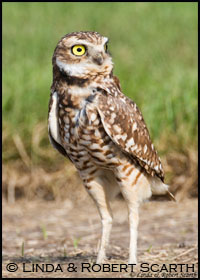introduction - galleries - technique - catalogue - notes - links - contact - blog - deep nature

Burrowing Owl
Burrowing Owls (Athene cunicularia) are ordinarily limited to the short grass prairie in the middle of North America or to Florida, and in South America. It is hard to find larger expanses of short grass in Eastern Iowa than a sod farm. While the workmen have enjoyed the company of a Burrowing Owl for two summers, birders just learned about the sod farm bird in September 2006. We spent a Saturday morning parked about 100 feet from one of the three holes that workmen say it uses. The top of its head was visible from several hundred yards as the foreman gave us directions. The sod was cut away to the field edge except for the little peninsula of green protruding a few feet out where the owl occupies what looks like a fox hole. This little vagrant is a welcome visitor.
The bird paid little attention to us and the other onlookers who stopped by. It is hard to miss vehicles parked in an open field recently stripped of its sod. As well as the owl, birders enjoyed the presence of the several hundred Killdeer on the still green half of the field, occasionally punctuated by Horned Larks, several immature American Golden Plovers, and what we are quite certain was a Buff-breasted Sandpiper. All were too far away for photographs, but visible in a spotting scope. Sod farm trucks and trailers whisked back and forth. The owl clearly regards them as acceptable presences in its chosen territory.
As he often does, Bob became almost invisible in plain sight of the owl. Wearing garden knees and inching his tripod ahead of him low to the bare ground, he worked his way close to ?friend owl? over the course of an hour. The bird must have eaten early and was ?ruminating? at the burrow. He looked about, occasionally napped, startled at something that flew over and then went back to resting, seeming to accept Bob and the tripod. There was a strong southeast wind with gusts that blew dust so he spent more time looking west. When the owl came out of his hole he walked about for a few minutes, flew a short distance to the west along the edge of the soybean field, came back to his hole and then flew east into the cornfield at about 10 o?clock. From other reports we saw, this was part of its regular routine was to leave the hole about 10 o?clock often going into the corn.
Burrowing Owls are threatened/endangered over sections of their original range because of development, insecticides, and prairie dog eradication. They also need larger mammals to dig out ground squirrels and provide burrows when there are no prairie dogs about. Only rarely to Burrowing Owls actually excavate their own burrows. After the owl left we noticed several ground squirrels, including this image of one who was cautiously exposing itself.
There are 171 owl species world-wide and this grassland owl is the only one that lives in a burrow. It also hunts by day while most hunt at night or at least at dusk. Burrowing Owls eat what?s available ? mice, voles, shrews, frogs, lizards, beetles and other large insects. When hunting, they often hover over prospective prey.
The Burrowing Owl, like the Little Owl of Europe, North Africa and Asia, takes part of its name from Athena, the Greek goddess of civilization (and war), wisdom, prosperity and the arts. She sometimes appeared as an owl and probably began as a bird goddess in prehistoric times. Just as the owl was a shape-shifter in Greek mythology, so it is in some North American Indian stories. This ability to adapt may protect the Burrowing Owl. It is civilization that is threatening this curious owl, but also is providing a home for it on sod farms, golf courses and short grass parks.
We write this the first week in October, which according to a field note in a 1914 issue of the Wilson Bulletin, was the time when Burrowing Owls migrated south from a western Iowa breeding site. The observer also noted that the farm dog on the property was attacked by adult owls if he came near their holes - a brave act by a five ounce bird, but befitting the goddess of battle protecting its home. We hope that this owl returns to its little sod house on the prairie in the spring and brings a mate.
? Linda & Robert Scarth, 2006.
First published in NatureScape News, 1 (11), 6, 2006.
